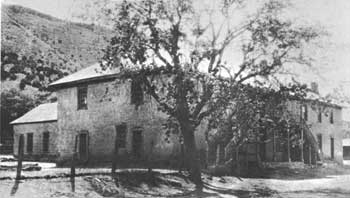






Survey of Historic Sites and Buildings
 |
LINCOLN HISTORIC DISTRICT New Mexico |
 |
| ||
Ownership and Administration. Various private owners except for the courthouse, which is State-owned.
Significance. Lincoln typifies in many ways the cowtowns that sprang up on the advancing cattlemen's frontier after the Civil War. Not a railhead town but a business and social community for the surrounding ranches, it attracted cowboys, gunfighters, badmen, rustlers, soldiers, and lawmen, and was the scene of conflicts over water, Government beef contracts, and grazing rights.
 |
| Lincoln County Courthouse about 1900. A Historic District today, in the 19th century Lincoln, New Mexico Territory, was a raucous cow-town, scene of cattle feuds and clashes between badmen and lawmen. (Courtesy, Museum of New Mexico.) |
Lincoln originated in the early 1850's as a Mexican village called La Placita del Rio Bonito. In 1869, when Lincoln County was created, the village was renamed Lincoln and became the county seat. At this time the cattle frontier was advancing westward, as well as northward, from Texas. Lincoln County—270,000 square miles in area—provided a natural home for these cattle because of its fine grass ranges and the ready market for beef at the nearby military posts and reservations. The king of the county was John Chisum, who alone owned 80,000 head of cattle.
At Lincoln occurred one of the most famous cattle feuds in the history of the West, the Lincoln County War in 1878. The rival Murphy and Tunstall-McSween factions fought a battle that lasted for 5 months and culminated in a 3-day gunfight on the streets of Lincoln, in which half a dozen men were killed. A prominent participant was William H. Bonney, better known as "Billy the Kid." Three years later, in 1881, killing his two guards, he dramatically escaped from the Lincoln County jail. But he was shot and killed several months later at Fort Sumner by Pat Garrett.
 |
| McSween Store at Lincoln, New Mexico Territory, as it appeared about 1900. It figured prominently in the Lincoln County War, in which Billy the Kid participated. (Courtesy, Museum of New Mexico.) |
Present Appearance. Aside from its dramatic history and its importance in the development of the cattle industry in southeastern New Mexico, Lincoln is historically important primarily because of its excellent state of preservation. It is probably the least spoiled surviving example of the frontier cowtown. Virtually the entire town of 1878 has survived with comparatively few modern additions.
The focal point of interest is the old county courthouse, built in 1874. This large two-story adobe structure was, until 1880, "the big store" of L. G. Murphy and Company, but it also housed offices, a billiard room, post office, living quarters, and a visitors' bunkroom. After Murphy went bankrupt as a result of the Lincoln County War, the county bought the building for a courthouse and jail. Minor repairs have been made to the building, but otherwise it is entirely the original construction. Now a State monument, it is also headquarters for the Old Lincoln County Commission, and it houses a county historical museum.
Another building of outstanding importance is the old Tunstall store, a long rambling adobe that figured prominently in the Lincoln County War. Numerous other business houses and residences dating from the 1870's and 1880's are also still standing. The Old Lincoln County Commission has placed markers throughout the town to identify important structures and sites. [29]
NHL Designation: 12/19/60
 |
 |
http://www.cr.nps.gov/history/online_books/prospector-cowhand-sodbuster/sitec13.htm
Last Updated: 22-May-2005